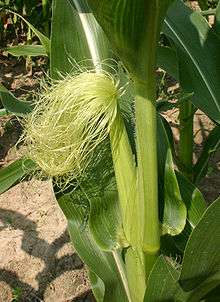Stigma (botany)


The stigma is the receptive tip of a carpel, or of several fused carpels, in the gynoecium of a flower. The stigma receives pollen and it is on the stigma that the pollen grain germinates. Often sticky, the stigma is adapted in various ways to catch and trap pollen with various hairs, flaps, or sculpturings.[1] The pollen may be captured from the air (wind-borne pollen, anemophily), from visiting insects or other animals (biotic pollination), or in rare cases from surrounding water (hydrophily).
Stigmas can vary from long and slender to globe shaped to feathery.
Pollen is typically highly desiccated when it leaves an anther. Stigmas have been shown to assist in the rehydration of pollen and in promoting germination of the pollen tube.[2] Stigmas also ensure proper adhesion of the correct species of pollen. Stigmas can play an active role in pollen discrimination and some self-incompatibility reactions, that reject pollen from the same or genetically similar plants, involve interaction between the stigma and the surface of the pollen grain.
Style

The style connects the stigma to the ovary. Styles are generally tube-like — either long or short. The style can be open (containing few or no cells in the central portion) or closed (densely packed with cells throughout). Pollen tubes grow the length of the style to reach the ovules, and in some cases self-incompatibility reactions in the style prevent full growth of the pollen tubes. Studies have shown that in some species,(including Gasteria,[3]) at least, the pollen tube is directed to the micropyle of the ovule by the style.[3]
In Irises and others in the Iridaceae family, there is a petaloid (or petal-like), style branch (or styloida),[4] which is a flap of tissue, running from the perianth tube above the sepal. The stigma is a rim or edge on the underside of the branch, near the end lobes.[5] Style branches also appear on Dietes, Pardanthopsis and most species of Moraea.[6] In Crocuses, there are three divided style branches, creating a tube.[7] Hesperantha has a spreading style branch. Gladiolus has a bi-lobed style branch. Freesia, Lapeirousia, Romulea, Savannosiphon and Watsonia have bifuracated (two branched) and recurved style branches.[6]
.jpg)
Attachment to the ovary



See also
References
- ↑ The Penguin Dictionary of Botany, edited by Elizabeth Toothill, Penguin Books 1984 ISBN 0-14-051126-1
- ↑ Anna F. Edlund, Robert Swanson and Daphne Preuss (2004). "Pollen and stigma structure and function: the role of diversity in pollination". Plant Cell 16 (Supplement): 84–97. doi:10.1105/tpc.015800.
- 1 2 Christophe Clement, Ettore Pacini, Jean-Claude Audran (EditorsAnther and Pollen: From Biology to Biotechnology, p. 151, at Google Books
- ↑ Focko Weberling of Flowers and Inflorescences Stigma (botany) at Google Books
- ↑ "The Anatomy Of Irises". herbs2000.com. Retrieved 27 July 2015.
- 1 2 Klaus Kubitzki (Editor) Flowering Plants. Monocotyledons: Lilianae (except Orchidaceae), p. 305, at Google Books
- ↑ Michael Hickey, Clive King 100 Families of Flowering Plants, p. 562, at Google Books
| Wikimedia Commons has media related to Stigma (botany). |
| ||||||||||||||||||||||||||||||||||||||||||||||||||||||||||||||||